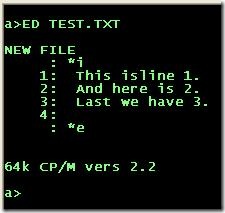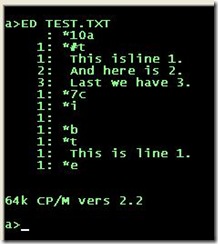| n |
A number alone will move the line position by the value of n and then display the current line. If n is negative the line position will move toward the start of the file. |
| n: |
A number followed by a full colon will move to the line numbered n if it is in the memory buffer. |
| :n |
If used before a command means from the current line to line n. |
| nA |
Append up to the next n lines from the edit file to the memory buffer. |
| B |
Move to the start of the first line in the memory buffer. |
| -B |
Move to the end of the last line in the memory buffer. |
| nC |
Move n characters to the right if positive or left if negative in the memory buffer. |
| nD |
Delete n character from the current file position. If n is negative the n prior characters are deleted. The first character deleted is the current one. |
| E |
End the current edit session. Write all remaining text to the temporary work file. Rename the original edit file with the file extension ".BAK" and rename the work file to the name of the edit file. |
| nFstring |
Search the memory buffer for the nth occurrence of the string. If n is positive the search is forward if negative the the search is done in reverse. When the string is found the current position is the character following the matched string. If the "F" is typed upper case the string is treated as all upper case if "F" is typed lower case string is treated as it is typed. |
| H |
Save the current edit session exactly as done by the "E" command. Then reopen the saved edit file and start a new edit session. |
| I |
Start input mode and insert the lines input from the console device until a Ctrl-Z (ASCII SUB, 1Ah) is read. If a capital "I" is typed then all input is converted to upper case ASCII. If a lower case "i" is typed text is added in the case it is typed. |
| Istring |
Insert the string of ASCII characters before the current character. |
| nJstring1 string2string3 |
The "J" command is used to do search and replace or search and insert on the lines in the memory buffer.A search is made for string1 the same as the "F" command. IF string1 is found string2 is inserted same as the "Istring" command. Finally delete all characters up to string3. If string3 is not found no delete will be done. If string2 is blank all text between string1 and string3 will be deleted.Each of the three strings is entered on a new line with the first parameter beside the "j" command. |
| nK |
The "K" command deletes n lines of text starting from the current line in the memory buffer. If n is negative the lines prior to and including the current lines are deleted. |
| nL |
The "L" command move the current position n lines from the current position. If n is negative the current line is moved back toward the start of the memory buffer. |
| nM |
The "M" command is used to repeat a series of commands n times. |
| nNstring |
The "N" command is used to search for the nth occurrence of string in the entire edit file starting at the currently selected line. The "N" command will execute the equivalent of the "W" and "A" commands in order to scan thru the remaining edit file. This search only operates in the forward direction. |
| O |
Restart the edit session abandoning all changes made to the edit file. The work file is deleted and the memory buffer is cleared. The ".BAK" file is lost. |
| Rfilename |
The "R" command is used to read a file and insert it into the current edit buffer. The text from the file filename.LIB is added to the edit session as the "I" command does. if filename is not supplied the file $$$$$$$$.LIB will be used. |
| nSstring1string2 |
The "S" command is used to perform search and replace. The string1 is found as performed by the "F" command. The string1 is replaced by string2. IF the command is invoked with uppercase "S", string1 and string2 are treated as all uppercase. |
| nT |
The "T" command is used to display n lines of text including the current line from the memory buffer. If the n parameter is not supplied a value of one is assumed. If n is negative the text lines prior to the current line are displayed.A special form of the "T" command "#T" will display all the text lines in the memory buffer from the current line. |
| U |
The "U" command forces all inserted text to ASCII upper case text. To set no case conversion the "-U" command is used |
| V |
The "V" command is used to display line numbers before the asterisk prompt. To display only the asterisk prompt used the "-V" command.A special form of the command "0V" will display the memory buffer free space and total size. |
| nW |
The "W" command writes the first n lines from the memory buffer to the work file. This frees space in the memory buffer to read the next lines from the edit file using the "A" command. The n parameter must be a positive number. |
| nX |
The "X" command is used to write a copy of the memory buffer text lines to the temporary file "$$$$$$$$.LIB". The line copy starts at the current text line and will copy up to n text lines. The n parameter must be a positive number.The "R" command is used to insert the temporary file into the memory buffer. |
| nZ |
The "Z" command will pause for n seconds on a four mega-hertz 8080. |








